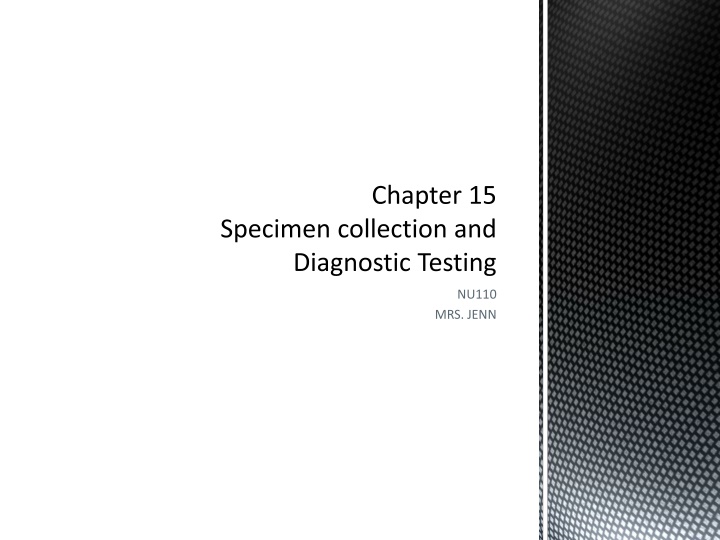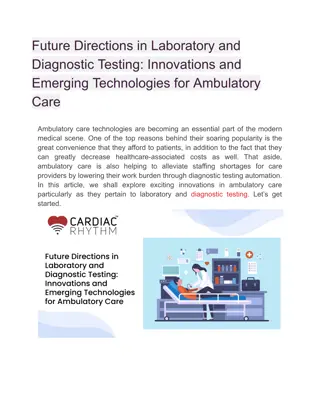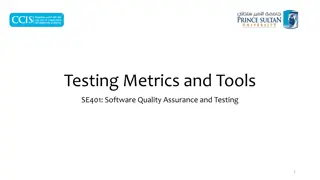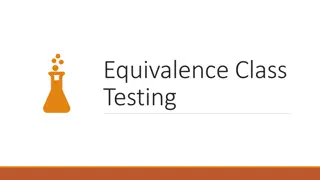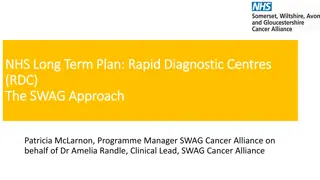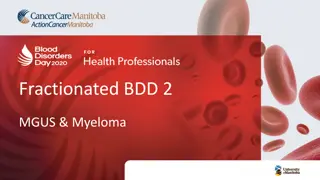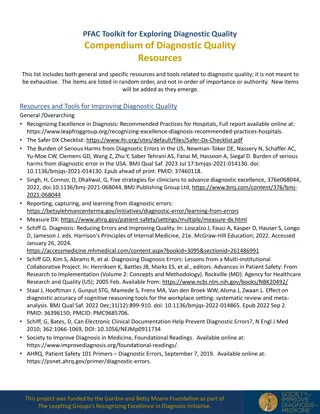Guidelines for Safe and Efficient Diagnostic Testing Procedures
This content provides detailed guidelines and procedures for specimen collection and diagnostic testing in healthcare settings, covering aspects such as patient assessment, specimen labeling, completing diagnostic requisition forms, and specific procedures like amniocentesis, arteriography, barium enema colon X-ray, and bone assessments. It emphasizes safety measures, patient education, and post-test care to ensure optimal outcomes.
Uploaded on Oct 09, 2024 | 1 Views
Download Presentation

Please find below an Image/Link to download the presentation.
The content on the website is provided AS IS for your information and personal use only. It may not be sold, licensed, or shared on other websites without obtaining consent from the author.If you encounter any issues during the download, it is possible that the publisher has removed the file from their server.
You are allowed to download the files provided on this website for personal or commercial use, subject to the condition that they are used lawfully. All files are the property of their respective owners.
The content on the website is provided AS IS for your information and personal use only. It may not be sold, licensed, or shared on other websites without obtaining consent from the author.
E N D
Presentation Transcript
Chapter 15 Specimen collection and Diagnostic Testing NU110 MRS. JENN
1. Assess patients educational level - start at 6thgrade level 2. Assess patient s knowledge of test 3. Verify consent form has been signed legal requirement review potential benefits and risks 4. Responsible to implement the pre, intra and post interventions to maintain patient safety at all times (Ex NPO, hold medications, private room, traction, PT/OT) 5. CLASS DISCUSSION Box 15-1 (page 368) the general guidelines for diagnostic examination) NURSE ROLE WHEN PERFORMING DIAGNOSTIC TESTING
LABELING SPECIMENS 1. Ensure doctor s Rx order 2. Adhere patient s sticker label 3. Nurse will handwrite date, time, and initials 4. Wear gloves 5. Place in red biohazard bag prior to transferring to Lab Dept. COMPLETING DIAGNOSTIC REQUISITION FORMS
PRE 1. <20 weeks pregnant full bladder to support uterus 2. >20 weeks pregnant - must void and empty bladder 3. FHR monitoring 30-60min ensuring fetus is not in distress 4. BP WNL ensuring mommy is stable AMNIOCENTESIS Obtaining a sample of amniotic fluid using a needle puncture into the uterus to screen for fetus POST 1. c/o N/V or dizziness lay mommy on L side to increase blood flow and nutrients to the placenta and fetus (avoiding compression on the uterus) ultimately increasing cardiac output to increase BP and HR developmental abnormalites (page 369)
PRE 1. Assess for allergy to IODINE DYE 2. Assess anticoagulant meds 3. Inform client that sometimes Iodine Dye causes flushing or warmth feeling 4. NPO 2-8 hrs POST 1. Bedrest x8 hours post op 2. Monitor VS and bleeding at puncture site 3. Encourage IVF and oral fluid intake to flush contrast IODINE DYE out of thru their kidneys ARTERIOGRAPHY ARTERIOGRAM Radiologic visualization of arteries by x-ray imaging after an injection of contrast media (page 369)
BARIUM ENEMA COLON X-RAY An x-ray exam to PRE 1. 1-day before clear liquid diet 2. NPO after midnight detect DAY OF 1. Administer suppository or cleansing enema until fecal return is clear why? abnormalities in the large intesting (colon) Liquid enema is injected into rectum thru a small tube (page 370) POST 1. Encourage food and fluid intake 2. Monitor BM s 3. Monitor VS and LAB RESULTS for dehydration and electrolyte abnormalities 4. Inform patient that BM will be white color until all the barium has passed and will eventually return to normal color
BONE PRE 1. Assess coagulation and anticoagulation medications 2. Sedative will be administered MARROW ASPIRATION and BIOPSY INTRA 1. Patient must remind very still thru-out procedure 2. Sites include: (a) posterior superior iliac (b) sternum (c) tibia (see picture T 15-1 pg 371) Aspiration-A small tissue sample in liquid form is removed from the soft tissue inside a POST 1. Apply pressure to puncture site 2. Apply dressing, observe bleeding 3. Monitor for shock s/s HR BP bone Biopsy- Actual marrow is removed from the bone
PRE 1. NPO after midnight 2. Preop med given to relax client 3. Ensure good oral mouth care done before to prevent infection during procedure BRONCHOSCOPY An endoscopic technique to look inside the airways for diagostic and therapeutic purposes. A bronchoscope is inserted thru the bronchiles thru the nose or mouth and s/t thru tracheostomy INTRA 1. Lidocaine mouthwash given. Do not swallow POST 1. Do not eat or drink 2-4 hrs postop. Ensure gag reflex has returned before introducing foods or drinks. How? Ask pt to swallow saliva ensuring no coughing or choking occurs 2. c/o sore throat give warm saline rinse, gargles or lozenges
PRE 1. Assess, pre-educate and encourage client to talk about concerns regarding claustrophobic fears and what alleviates anxiety. May need to pre-medicate 2. Assess for IODINE DYE allergy 3. Client must remain very still thru out scan 4. NPO up to 4 hours before CT SCAN COMPUTED TOMOGRAPHY SCAN (use x-rays) or MRI SCAN (use powerful magnetic fields and radio frequency pulses) in a small claustrophobic machine to give a detailed picture of organs, soft tissues, bone and other internal organs POST 1. Encourage IVF and oral fluid intake to flush contrast IODINE DYE out of thru their kidneys
*EXERCISE STRESS TEST *EXERCISE TOLERANCE TEST *TREADMILL TEST Helps the doctor find out how well your heart handles a workout. It shows if the blood supply is reduced in the heart arteries. Used to diagnose Coronary Artery Disease (CAD). PRE 1. NPO for food and drinks only x4 hrs. Ok to drink water to take heart medications 2. No smoking 3. VS taken before, during and after 4. Obtain ECG - if abnormal cancel test INTRA 1. Wear comfortable workout clothes and shoes 2. Verbalize chest pain or SOB and test will be stopped POST 1. Go home and rest 2-4 hours post do not shower or bath. Just relax initially.
PRE 1. NPO x8 hours before GTT *ORAL GTT TEST *GLUCOSE TOLERANCE TEST INTRA 1. Client will drink 8 ounces of oral GTT sugary syrupy glucose drink. Wait in office/lab x1 hr (75 grams sugar) x2 HR (50 grams sugar) x3 hours (100 grams sugar) and blood drawn to see how it affects your glucose level Used to diagnose DM or GDM 1 hour test 2 hour test 3 hour test or 30 minute test 60 minute test 90 minute test POST 1. Instruct client to eat/snack 2. May have to administer insulin
1. GTT Client drinks sugary syrupy drink at 30min-60min-90min or 1hr-2hr-3hr intervals and gets blood draw after each interval 2. ACCUCHECK Client gets side of digit pricked to obtain a small droplet of blood sample to be transferred to a glucose testing device. Can be performed by patient him/herself, family, TECH, CNA, UAP, or other health care professional 3. HbA1c TEST A method to test glucose over a long-term 3 month period 4. FASTING SERUM GLUCOSE TEST Client is NPO after midnight 10-14 hours and tested before food or drink is consumed Know the 4 different types of Glucose Testing
PRE 1. Do not eat foods that will affect results x3 days such as no red meat, no cantaloupe, no uncooked broccoli, no turnips. 2. Do not take meds that will affect results x2-3 days no aspirn, no Vit C, no NSAIDS. 3. Recommend HIGH RESIDUE DIET *HEMOCCULT STOOL TEST *GUAIAC TESTING *HEMATEST *gFOBT Test (can be done by UAP Skill 15-7 page 392)) A small stool sample tested for hidden fecal occult blood (FOB) to diagnose colorecteral cancer, GI Bleeding INTRA 1. Urine can not be mixed with stool
PRE 1. Assess for contrast dye allergy 2. Administer laxatives 3. NPO after midnight 4. Assess and review urinary lab results BUN, creatinine and renal functioning *IVP TEST *IUG TEST Contrast dye is injected into client s vein than a series of x- ray pictures taken to look for disease of the urinary tract or kidney stones, tumors or POST 1. Encourage IVF and oral fluid intake to flush contrast IODINE DYE out of thru their kidneys 2. Monitor urinary output closely. Should be 30-50cc/hr infection
*KUB U/S *KUB X-RAY *KUB STUDY (kidney-ureter-bladder) NOTE 1.No contrast dye injected 2.No NPO 3.No sedation Used to diagnose renal or GI problems r/t GI pain, gallstones, kidney stones, foreign object, intestinal blockage, and tumor. Done in radiology dept. Lead apron placed over body parts not x-ray ed, patient lays very still and x-ray picture taken. INTRA 1. Clothing over KUB site will be removed
PRE 1. NPO after midnight 2. IV sited to IVP a relaxant med 3. Biopsy needle site will be numbed 4. Patient in supine position LIVER BIOPSY A small needle is inserted into the liver to collect a tissue sample to diagnose liver cancer or liver infection. INTRA 1. Biopsy needle inserted to bottom of rib cage on R side while patient is holding his/her breath POST 1. Monitor VS post 2. Rest 2-4 hrs post recovery room on R side to control the bleeding by compressing against puncture site. Than bedrest 24 hrs at home. 3. No lifting >10lbs or exercise for 1-2 weeks 4. No coughing or straining x 1 week
BIOPSY TESTING NOTES Any biopsy testing, typically, causes *PAIN POST-OP Therefore, it is important to lessen pain as much as possible by performing nursing interventions that minimize pain and providing continuous pain relief measures
*LP PRE 1. Patient needs to void or have BM INTRA 1. Patient lays on L side, needle is inserted any where between L3-L4 or L5-L6 interspaces. POST 1. Patient must remain in SUPINE position with HOB less than 30 degrees to prevent potential postpuncture spinal headache. 2. Encourage fluids via straw to keep HOB less than 30 degrees 3. Monitor patient for c/o numbness, tingling or non-movement of extremities *LUMBAR PUNCTURE *SPINAL TAP A procedure to collect and look at the cerebrospinal fluid (CSF) surrounding the brain and spinal cord to diagnose meningitis, myelitis, and demyelinating diseases such as Multiple Sclerosis or cancers that affect the brain or spinal cord.
Other Diagnostic Tests: 1. Mammogram 2. Paracenthesis 3. PET 4. Sigmoidoscopy 5. Renal Angiography 6. Thorancentesis 7. Ultrasound 8. U GI Series Testing 9. Urinalysis 10. Kidney Biopsy
IT IS NURSE RESPONSIBILITY TO PREVENT INACCURACIES DURING DIAGNOSTIC TESTING OR SPECIMEN COLLECTION: CLASS DISCUSSION: PREVENTING AN ERRONEOUS RESULT 1. Wash hands, wear gloves to prevent contamination of specimen 2. Ensure medication if held if needed to prevent a drug interaction 3. Ensure proper diet is followed or NPO is done or avoiding foods are practiced 4. Ensure specimen is sent to LAB ASAP 5. Ensure the correct amount of specimen is collected to test it 6. Verify if specimen should be kept on ice, refrigerated or at room temperature Box 15-3 (page 383)
STUDENTS MUST BE FAMILIAR WITH THESE SKILLS BEFORE LAB DAY: REVIEW YOUTUBE VIDEO FROM ACCREDITED NURSING COLLEGE OR UNIVERSITY: SKILL 15-2 Midstream UA SKILL 15-3 Sterile UA from Foley port SKILL 15-4 24-hour UA SKILL 15-5 Accucheck SKILL 15-6 Stool specimen collection SKILL 15-7 HEMOCCULT SKILL 15-9 SPUTUM SPECIMEN SUCTION SKILL 15-10 SPUTUM COLLECTION SKILL 15-11 THROAT CULTURE SKILL 15-12 NOSE CULTURE LAB SKILLS TO KNOW:
